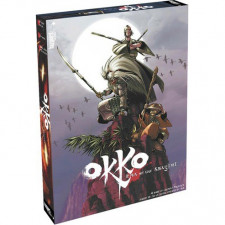Okko: Era of the Asagiri Review
on Apr 8, 2015
Based on a series of comics set in a feudal Japanese fantasy world, Okko is a skirmish game for two players. The comics’ quality artwork makes a seamless transition to the six double-sided modular game boards, two dozen cardboard standees, custom player and equipment cards. Scenes from the comics permeate the rulebook and scenario book, adding life to the game’s universe, and ten custom dice allow players to tailor combat between demons and warriors once the action begins. When it begins, it usually ends fast, and rapid violence is the essence of Okko.
Players start with a pre-made scenario or by building their force using a point system to choose fighters and special items. Maps with varying terrain are set up, standees placed and the first player rolls their five special dice, using symbols on these dice to boost fighter abilities or activate skills in the coming turn. Unused dice are placed in reserve on specific fighters’ cards to be used in defense during the opponent’s turn.
Okko combat is like the samurai’s iai draw; a stroke delivered while drawing the sword, causing instant death. Seemingly simple, but layers of skill and planning reveal himself under further scrutiny. On the surface, combat has four possible results: a draw, a retreat, shaken or disabled. A shaken opponent has their card flipped to its weaker side, reducing or changing abilities, and a disabled fighter is removed from play. If an opponent can’t retreat, they’re shaken. Two shakes and they’re disabled, whether they’re a peasant, demon or the game’s ronin namesake. Or they can be disabled on the first blow. No hit points. Beautiful simplicity.
Combat resolution is the game’s dividing point thanks to the strategic gamer’s old nemesis: the traditional d6. Once attacker and defender add bonuses due to facing, supporting fighters, special skills and abilities to their Attack or Defense score, each rolls the d6 and adds that to their total. The loser faces the results. What makes this mechanic controversial is the impact of the last die.
Attack/Defense ratings vary from two to five, and most battles involve a single modifier per combatant, so values are generally within one or two of each other before the die is rolled, and therein lies the rub. A large portion of Okko conflicts boil down to who rolls the six and who rolls the one. Fans of action movies may rejoice while fans of Feld may flip the table. I lean toward the former, but have felt the frustration of a lightweight killing my champion outright due to that roll. My demons have struck down every one of Okko’s companions, then, outnumbering him four to one, watched as he dispatched my entire force to give my opponent the win. Cinematic? No doubt. Frustrating? Depends on who rolled the one.
Fans online have found a variant to mitigate that somewhat, a variant the designer himself added to the game’s first expansion, but played as is the d6 looms above all waiting to drop the hammer. What this does is enable a swift end to most Okko games. If you’re playing a linked campaign, it’s likely you can resolve the whole affair in one evening, and equally likely the d6 will enrage all sides at least once during the session. The die giveth spectacular, instant victory and taketh away well-crafted strategy. This holds different appeal to different gamers.
Okko: Era of the Asagiri allows two blademasters to trade blows, driving each other across inns, through forests or over bridges before one wrong move leaves the opening for a decisive strike. It also allows a humble foot soldier to get charged by that very same blademaster, turn aside his attack and strike him down at the start of the fight. A part of me loves the cinematic nature of the conflict. Another part wants to create a stunning action sequence where my sword-wielding hero strikes down wave after wave of incompetent minions, but knows how unlikely it would be. The six will always be there, waiting for me to roll a one, and that can ruin a movie.

 Customer Support
Customer Support  Subscribe
Subscribe 




 Account
Account  Wishlist
Wishlist 

